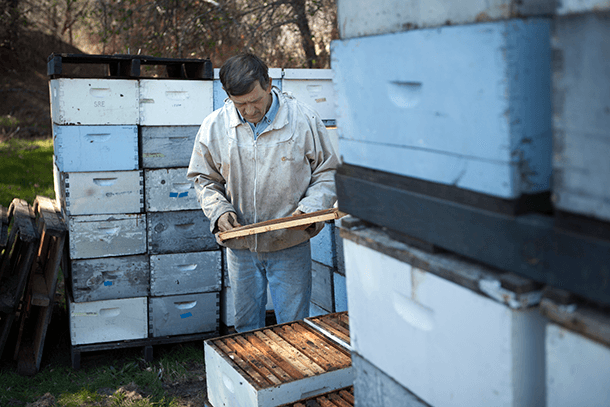The EPA broke the law when it approved a new pesticide
Minnesota beekeeper Steve Ellis stands in front of once bee-filled boxes that were left empty after being hit by colony collapse disorder.
The EPA failed to follow its own rules for ensuring chemical safety and illegally approved a powerful insecticide linked to declining numbers of honeybees, a federal appeals court has ruled.
The Ninth Circuit Court of Appeals found the EPA failed to get enough evidence from the manufacturer, Dow AgroSciences, to approve the safety of Sulfoxaflor. Sulfoxaflor is a neonicotinoid, a systemic insecticide that becomes embedded in a plant’s tissues and is poisonous to insects.
“The court found that EPA approved Sulfoxaflor without any reliable information about the risk that it would present to honeybee colonies,” explains Greg Loarie, a staff attorney for Earthjustice, one of the plaintiffs in the case. “That, of course, is a huge shortcoming when we’re in the midst of this crisis in which we are losing over one-third of our honeybee colonies every year, and science is pointing to these sorts of insecticides as a primary cause.”
The case began in the summer of 2013, shortly after EPA approved Sulfoxaflor. Earthjustice was approached by several US commercial beekeeping trade groups, including the American Honey Producers Association and the American Beekeepers Federation.
“They asked, ‘Is there anything we can do about this latest neonicotinoid coming onto the market,’” Loarie says. “We took a look at the registration and found that indeed EPA had not met its own guidelines. It didn’t have the information that it was supposed have in hand — and so we filed suit.”
Under the law, this type of case bypasses the lower courts and goes straight to the court of appeals. Courts typically give EPA a great deal of deference in these matters because they involve a fair amount of scientific expertise; the courts are often recluctant to second-guess the science.
But in the case of Sulfoxaflor, Loarie says, “the science was so lacking and it was so clear that EPA just didn’t have this fundamental information, the court found that the registration had to be overturned unless and until that information is brought to bear.”
The way the law is set up, when a company wants to register a chemical with the EPA, the manufacturer of the chemical does the testing and then submits the results to the EPA for review. Dow submitted six studies to the EPA. EPA found that all six of the studies had numerous scientific flaws and were inherently unreliable, Loarie says.
“For instance, most of them studied an exposure to Sulfoxaflor that was well below what would actually be happening in the field and several of them lacked control groups of any kind,” he explains. “Yet, EPA decision-makers decided to register Sulfoxaflor, notwithstanding the flaws inherent in the studies.”
To determine the impact a insecticide will have on what they call “non-target insects,” like honeybees, EPA looks at what it calls the “acute toxicity” of a pesticide. “Essentially that means they take a honeybee into the laboratory, they expose that individual adult honeybee to the pesticide, and they figure out how much of the pesticide it takes to kill that adult honeybee,” Loarie explains.
If they find that bees will be exposed to less than that lethal dose, they conclude the pesticide will not cause any problems to the bee population. But this process falls to pieces when you factor in the systemic insecticide overlay, Loarie says.
“It may not kill on contact, but the adult bee might go out into the field, collect pollen that has the Sulfoxaflor or the systemic insecticide in it, and bring the pollen back into the hive.”
Over time the build-up of the systemic insecticide within the hive causes the whole colony of bees to sicken, weaken and ultimately collapse. The law says EPA needs to consider this possibility, Loarie explains.
“EPA has to consider what happens when we put a hive out in the real world and put it in a situation where it is feeding on crops that have been sprayed with the systemic insecticide,” Loarie says. “That’s the information EPA so desperately needs and the information that it certainly lacked in the case of Sulfoxaflor.”
Now that the court has set aside EPA’s decision to register Sulfoxaflor, the pesticide is off the market unless and until Dow submits to EPA the proper information and EPA goes through the review process again — and follows the law this time around, Loarie says.
This story is based on an interview that aired on PRI’s Living on Earth with Steve Curwood
The story you just read is accessible and free to all because thousands of listeners and readers contribute to our nonprofit newsroom. We go deep to bring you the human-centered international reporting that you know you can trust. To do this work and to do it well, we rely on the support of our listeners. If you appreciated our coverage this year, if there was a story that made you pause or a song that moved you, would you consider making a gift to sustain our work through 2024 and beyond?
